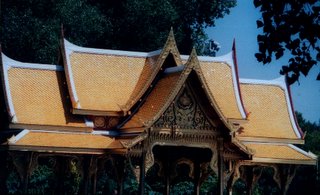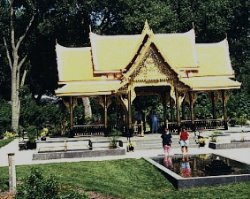 The Thai Pavilion is one of only four outside of Thailand, with the other three being in Hawaii, Germany and Sweden, and the one in Madison is the only one outside Thailand surrounded by a garden. The Pavilion was a gift to the University of Wisconsin-Madison from the Thai Chapter of the Wisconsin Alumni Association and the government of Thailand through its king. It opened in June 2002 and has quickly become a popular choice for wedding photos.
The Thai Pavilion is one of only four outside of Thailand, with the other three being in Hawaii, Germany and Sweden, and the one in Madison is the only one outside Thailand surrounded by a garden. The Pavilion was a gift to the University of Wisconsin-Madison from the Thai Chapter of the Wisconsin Alumni Association and the government of Thailand through its king. It opened in June 2002 and has quickly become a popular choice for wedding photos.Open-sided pavilions such as this one, known as a “sala” in Thailand, are a common sight throughout Thailand. Although they are often located on religious sites, they are secular structures commonly used as shelter from rain and heat. They may also be used for weddings, picnics and other celebrations, as well as quiet reflection.
Highly ornate, these pavilions display the craftsmanship of Thai artisans and are constructed without nails, screws or metal fasteners of any kind, and bear the Royal seal of the Thai crown. The pavilion at Olbrich is adorned with gold leaf, red lacquer finish and ornate decoration. Measuring 40 feet long, 22 feet wide, and 30 feet high, the sala is worth between 1.5 and 2 million dollars.
 The Thai Pavilion is reached by crossing an arched ornamental bridge spanning Starkweather Creek and a curving path along which grows lush flowers and fauna. There is a reflection pool, three tranquil pools and benches placed around the pavilion. Only lotus flowers, a sacred plant in Thailand, grow in the reflection pools. Pavilions are usually situated in pretty places and, if possible, near flowing water. To the Thai people, access to water has implications for good health and prosperity.
The Thai Pavilion is reached by crossing an arched ornamental bridge spanning Starkweather Creek and a curving path along which grows lush flowers and fauna. There is a reflection pool, three tranquil pools and benches placed around the pavilion. Only lotus flowers, a sacred plant in Thailand, grow in the reflection pools. Pavilions are usually situated in pretty places and, if possible, near flowing water. To the Thai people, access to water has implications for good health and prosperity.Plants chosen for the garden are similar to those found in Thailand, bearing in mind climatic differences. Since palms and banana trees are out of the question, there is more emphasis on ornamental grasses and textured plants. Thai gardens are generally serene, with more emphasis on texture and form than color. One of the plants being substituted is giant miscanthus, which grows up to 12 feet tall and looks similar to bamboo. There are also potted conifers and sculpted tree art, as well as interesting sculptures located along the serpentine path leading to the sala.





No comments:
Post a Comment